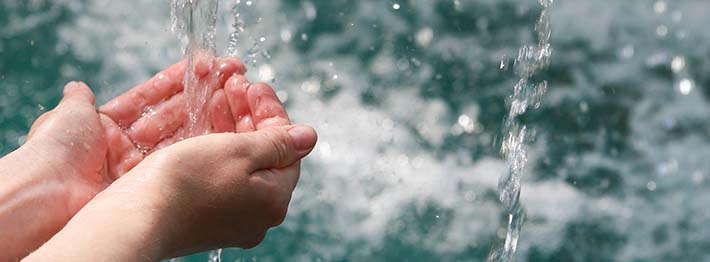
Fanshawe College is located right in the middle of one of Canada's greatest natural treasures, the Great Lakes system. In fact, some of our campuses are found right near the shores of Lakes Erie and Huron. The Great Lakes – and thousands of square kilometres of rivers, lakes, ponds and tributaries that connect them – form the largest freshwater system in the world, with more than 20 per cent of all the world’s fresh water. However, their value is often overlooked. Providing everything from clean drinking water to shipping, power generation and opportunities for recreation, Ontario's waterways represent a precious resource.
Unfortunately, that resource is not endless. Rising water levels, melting ice caps, widespread droughts and pollution continue to threaten the delicate balance of our natural ecosystems. It’s important to use water wisely.
What can students do to conserve water?
Most students want to be smart about water in order to save money and take care of our resources. Try making some of these 10 simple water-saving changes to your daily life and you can save a few bucks on your bottom line while helping to preserve water supplies for future generations.
1. Carry your hydration station
Rather than buying plastic bottles of water daily, use a thermos or refillable water bottle (and use tap water to fill it) to help save money while keeping yourself hydrated. When it's safe to do so, you can even use Fanshawe's complimentary water bottle refilling stations to top up if you're on campus.
2. Get the most out of a cycle
Only wash full loads of dishes or laundry to help limit dishwasher and washing machine use. Also, be sure to use the shortest cycle possible on the machine, and if there is a water-saving setting, use that too!
3. Take shorter showers
The average shower of about 10 minutes uses around 100L of water. You could save 50L of water by cutting your shower time in half. If that seems like too much, just start by cutting one or two minutes off your total time… it all adds up!
4. Tame the tank
Fill a plastic bottle with water and place this bottle into the tank of your toilet. By doing this, you create displacement that reduces the amount of water used to fill the tank and flush the bowl, without interfering with the mechanics of the toilet. The water savings add up with every flush!
5. Don't let the water run
Turn off the tap while shaving, brushing your teeth, hand washing your dishes, etc. Did you know you can save up to 750L of water per month just by turning off the tap when you don't need the water flowing? If you want cold water, fill a jug and place it in the fridge to chill. In labs, shops and studios, clean up with buckets of water where possible rather than running the tap or hose.
6. Reuse water
When washing fruits and vegetables, fill a bowl with water and use that to rinse your produce rather than running the tap. After you're done, use the 'leftover' water for watering plants. You can also collect rain water to reuse, or even pour out the last drops from a used drinking glass.
7. Stop losses at the source
If your sink or bathtub drips once per second, you'll waste more than 11,000L per year. Report leaks or running water to your landlord or Residence Advisor or to your professors if the problem is in a learning space. Don't forge to close your taps tightly to prevent slow drips, and watch your water meter readings improve.
8. Go low flow
Install low flow faucets, aerators and showerheads (or ask your landlord to install them) to reduce the amount of water that comes out of the faucet. "Low flow" means the fixture uses less than 9.5L of water per minute.
9. Leave the lawn 'til later
In the summertime, do not water your grass during the day. If you do choose to water your lawn, be sure to water at night to reduce the amount of evaporation and to ensure your grass is able to drink the most water it can. To help it, water slowly and deeply to avoid surface runoff that doesn't reach the roots.
10. Keep it clean!
Remember, water conservation isn’t just about reducing how much you use; it’s also about making sure the water we do use does not end up contaminated.
When using things like soaps, detergents and cleaners, buy from companies that you know do not use harmful ingredients. Natural ingredients clean just as well as synthetic ones, but once they go down the drain you don’t have to worry about environmental harm. Check out the rating for your cleaning products at https://www.ewg.org/guides/cleaners/.
Sometimes global environmental issues can feel beyond our individual control, but little actions add up, especially when enough people put them into practice together. Conserving water can be easy, and it pays off in savings now as well as protecting resources for the future.
Click here to learn more about Fanshawe's commitment to environmental sustainability.






